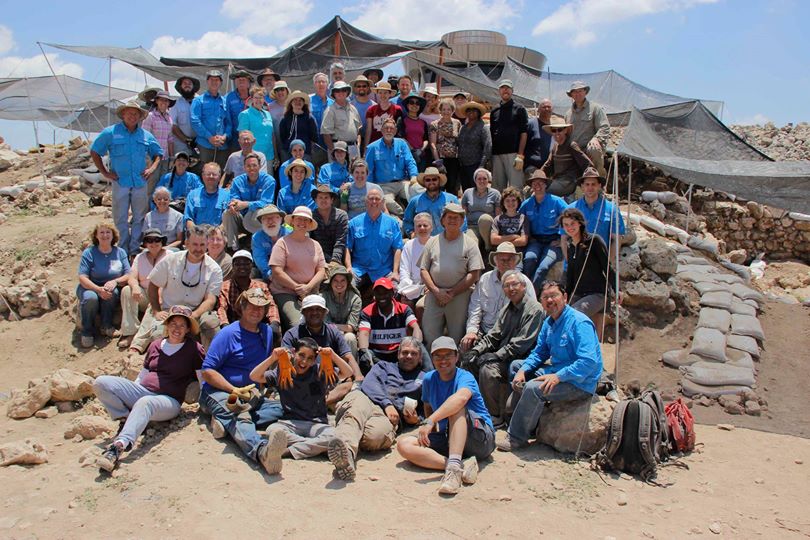After six weeks of excavation, conservation, and processing at ancient Shiloh, the ABR team headed back to the States. During Season One at Shiloh some very fascinating artifacts came to light that are already shedding light on the occupational history in several important ways.
First, the team identified evidence that corrected the misconception that the Early Roman (New Testament) town existed only on the southern side of the tell. An abundance of Early Roman pottery, objects, and architecture in field H1 on the northern slope disproved this misconception. Although the New Testament does not record that Jesus visited Shiloh, it seems highly likely that he did, since his itinerary took him right by the site.
Second, the team uncovered an abundance of mud bricks on the outside and inside of the MB III (1650–1550 BC) fortification wall. In Israel Finkelstein's excavation at Shiloh (1981-1984), he found a meter of mud bricks, yet concluded that the walls did not support a mud brick superstructure. The evidence, however, points to the existence of such a superstructure, similar to the one at Jericho.
Third, based on the IA I (1177–1000 BC) destruction in Area C, Finkelstein surmised that the Philistines destroyed Shiloh in 1050 BC after the Battle of Ebenezer when the Ark of the Covenant was captured (1 am 4). However, the ABR team failed to identify a destruction layer between IA I and IA II (1000–586 BC). In fact, IA II pottery outnumbered IA I pottery.
Fourth, far more animal bones exist at Shiloh than in our previous dig at Khirbet el-Maqatir. These bones are currently being analyzed by the staff zooarchaeologist at Tel Aviv University. This will indicate if they were mainly from young sacrificial animals, a phenomenon that Finkelstein found in Area D.
By the end of Season One (see additional reports here), three teams reached bedrock on the outside of the 5.3 meter-wide fortification wall, at a depth ranging from 3.1 to 4.5 meters. The NW sector connected with the work of the Danish in the 1920s, and the NE sector connected with the work of Finkelstein in the 1980s.
Over the next two seasons, ABR hopes to fully expose the northern fortification wall. This will clarify what type of site (city or cultic area?) existed there in biblical times. 109 volunteers and staff worked for a minimum of 1 week, and another 91 worked at least one day. 200 volunteers and staff makes Shiloh the largest dig in Israel this summer. Not bad for Season One!

View Photos of the Shiloh Excavation on the ABR FaceBook Page: Shiloh Excavations Photo Album 2017
The dig merited a good bit of media coverage. Patterns of Evidence II filmed Director of Excavations, Dr. Scott Stripling, at Shiloh, Khirbet el-Maqatir, and the École Biblique for their upcoming documentary (2018). They also filmed Dr. Bryant Wood at Khirbet el-Maqatir. An Israeli company filmed various team members for a documentary on the history of Shiloh. The Times of Israel ran a major story on July 17th on the Shiloh dig. This story was picked up by many other news agencies (in several languages!), including Fox News. Altogether, media exposure in Season One exceeded expectations.
Now comes the paperwork. While the core staff, led by Excavation Director Stripling and IT Director Don McNeeley, have already begun work on the 2017 annual report, two other peer-reviewed articles are in the works by top Israeli scholars who worked with ABR during this season. Baruch Brandl is publishing a seal impression and two scarabs (all from MB III) and Frankie Snyder is publishing the five beads from Season One.
During the past year, the team worked to incorporate several cutting-edge technologies for introduction at Shiloh this season. These included paperless documentation via I-pads, drone pictures, and wet-sifting.
Registrations for the 2018 season are now being accepted. The pricing and paperwork can be found at www.DigShiloh.org. Inquiries can be directed to Henry B. Smith Jr., Administrative Director.
You can also make donations to support the ABR Shiloh Excavation here on the ABR website. Just type a note "Donation for the Shiloh Excavations" in the Special Instructions field.